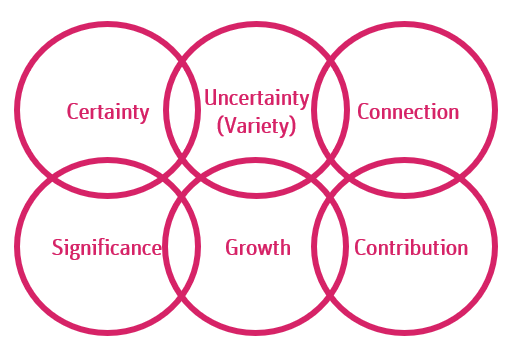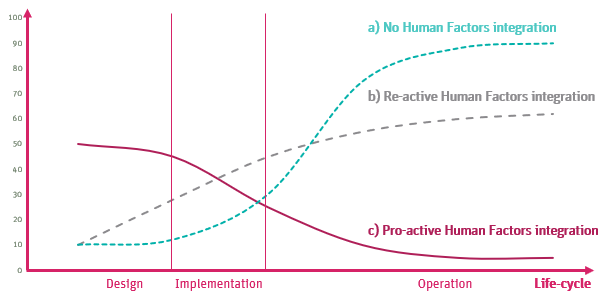A Human Factors approach to Recovery Solutions
For the past few weeks, soon to be months, we’ve all been counting numbers, looking at exponential graphs in an attempt to gain a deeper understanding of our ever-changing role within this new context. But how is tracking these numbers helping our personal and professional lives, other than compounding the general mood of uncertainty?
WE CAN ALL BE GAME CHANGERS
Why not leave the data scientists to do their jobs while the rest of us focus on what we can do to bring some certainty back to the game? We are all craving certainty these days as, according to Tony Robbins, it is one of the most significant basic human needs. Feelings of anxiety and panic that can lead to rash decisions are only natural during unprecedented times when not all our needs are being fulfilled. But how do these decisions fit within your life or your company’s manifesto and recovery strategy?
At Think, now more than ever, we think it’s the time to connect with the industry and take positive steps; identifying with our client’s common goals during this highly volatile context.

The 6 Human Needs according to Tony Robbins
A Human Factors Approach to Crisis Management
WHEN TIME BECOMES AN “AFFORDABLE” LUXURY
Just take a step back and think about what your company’s end goal is? How can the company get there? Are the short-term decisions you make in service of that goal? Or do they push you further away from success? This can be counterintuitive, but the price paid for one step back (allowing time to reflect) could pay back with interest through a successful marathon moving forward. Does the current crisis make time an affordable luxury?
BENEFITING FROM A PEOPLE-CENTRIC APPROACH
Taking more time to support informed decision making is a Human-Centred Approach to the current situation. Once you define the knowns and unknowns, you can understand and project the optimal direction of travel that best positions you and your company for the future; ensuring a smooth strategic journey towards freshly-reassessed goals.
As a Human Factors specialist with applied experience in various industries (from aviation, automotive, medical devices and now back to aviation), I can’t help but remark how similar this model it is to the investment in Human Factors integration in the early phases of a project life-cycle and in particular the struggle to demonstrate the potential savings of such an approach.

Cost of Detecting and Resolving Human Performance Issues (Source: Eurocontrol)
Therefore, while the skies are quiet, we can all take a much needed (if not desired) deep breath of fresher air (as Carbon emissions have fallen sharply) and re-assess the situation. But enough with the metaphors. Time to consider how this model can apply to your company and think about all the “nice to have” services and capabilities that you strive for but have never had the necessary time to address. If time is now an abundant commodity, let’s make the most of it!
As a relatively new starter here at Think, I am very appreciative of the way our company management is tackling this. Our strategy is simple: we are taking this time to better ourselves and prepare to serve our ATM and Airport customers with even better, more innovative solutions for the future. Meanwhile, our Human Factors specialists are working closely with the wider team to identify opportunities to further develop internal capabilities that will then help us to save our customers effort, time and money. As part of this effort, we are developing a range of new services such as the remote management of Real Time Simulations (r-RTS) and more integrated services to reduce the cost and risk of airspace, concept and system changes across ATM and airport operations. This includes incorporating Human performance principles to all Think services.
We are part of the solution for timely recovery
Although widely acknowledged, the merit of embedding Human Performance principles within aviation projects is still a hard sell when it comes to funding decisions. Our experience tells us that taking a human centric approach from the outset reduces risk and saves cost. This is particularly important when considering recovery planning.
We are keen advocates of “one size does not fit all”, meaning that the most fitting solution is within each organisation, depending on strategic goals, company culture and business model. We currently follow a goal-driven Human Factors process to identify, refine and then build the most effective and cost-efficient path to successful project delivery. These principles provide a common framework for elaborating recovery plans.

Proposed high level Human Factors approach to fast recovery
This discipline, at its core, aims to reduce and mitigate the risks to aviation safety. To do so, we must influence attitudes and behaviours while embedding Human Factors principles into everything we do. Similarly, as changing times require novel proactive thinking with an even greater focus on the resilience of our organisations and our ability to enable recovery.
There is power in positive thinking
The aviation industry is a community of keen and passionate people, everyone playing a critical role in the overall value chain. And therefore, we think that effective collaboration and continuous support will not only help us push through these times but become stronger and better positioned at the end of it.
In order to keep moving forward, it is very important to remain vigilant to avoid the instinct to make rash decisions and the risk of procrastination. At Think, we strongly believe in the power of a proactive mentality when times get hard. We are staying engaged, talking with our colleagues and supporting our customers to the best of our abilities; whilst also safeguarding internal development. We recognise that we have little control over external factors, but we do own our response.
We are here to help the industry not only recover but continue expanding to accommodate future sustainability by achieving common goals.


Author: Diana Toma, ATM Consultant


Recent Comments